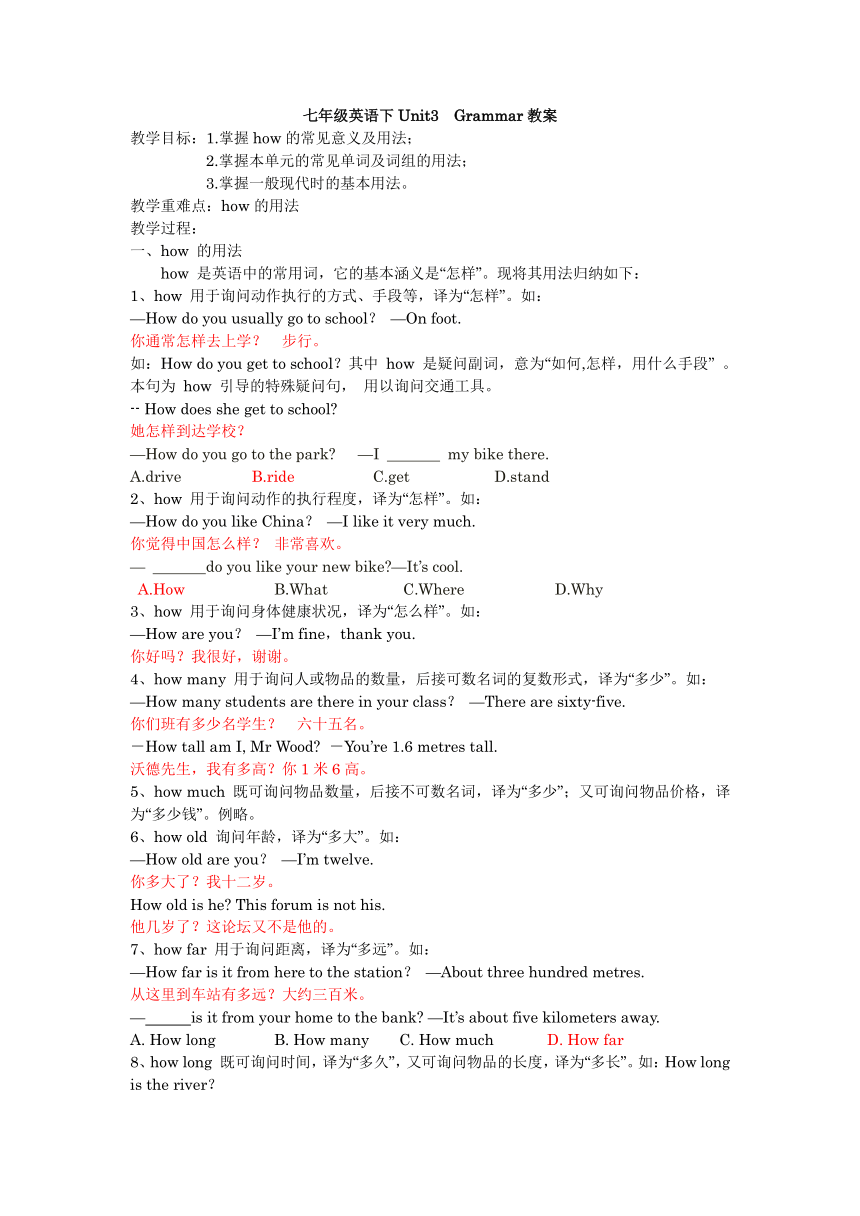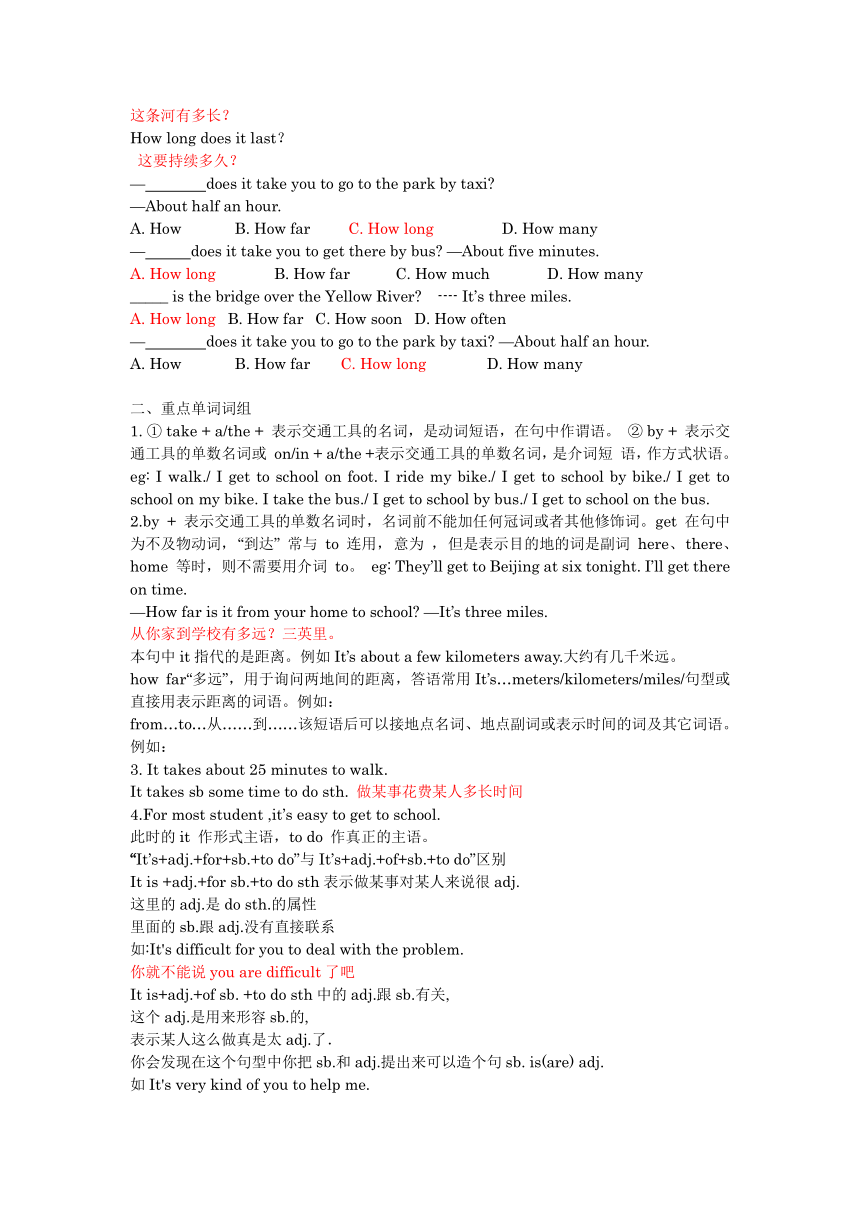七年级英语下Unit 3 How do you get to school? Grammar教案
文档属性
| 名称 | 七年级英语下Unit 3 How do you get to school? Grammar教案 |  | |
| 格式 | zip | ||
| 文件大小 | 21.6KB | ||
| 资源类型 | 教案 | ||
| 版本资源 | 人教新目标(Go for it)版 | ||
| 科目 | 英语 | ||
| 更新时间 | 2020-03-08 22:31:33 | ||
图片预览


文档简介
七年级英语下Unit3 Grammar教案
教学目标:1.掌握how的常见意义及用法;
2.掌握本单元的常见单词及词组的用法;
3.掌握一般现代时的基本用法。
教学重难点:how的用法
教学过程:
一、how 的用法
how 是英语中的常用词,它的基本涵义是“怎样”。现将其用法归纳如下:
1、how 用于询问动作执行的方式、手段等,译为“怎样”。如:
—How do you usually go to school? —On foot.
你通常怎样去上学? 步行。
如:How do you get to school?其中 how 是疑问副词,意为“如何,怎样,用什么手段” 。本句为 how 引导的特殊疑问句, 用以询问交通工具。
-- How does she get to school?
她怎样到达学校?
—How do you go to the park? —I my bike there.
A.drive B.ride C.get D.stand
2、how 用于询问动作的执行程度,译为“怎样”。如:
—How do you like China? —I like it very much.
你觉得中国怎么样? 非常喜欢。
— do you like your new bike?—It’s cool.
A.How B.What C.Where D.Why
3、how 用于询问身体健康状况,译为“怎么样”。如:
—How are you? —I’m fine,thank you.
你好吗?我很好,谢谢。
4、how many 用于询问人或物品的数量,后接可数名词的复数形式,译为“多少”。如:
—How many students are there in your class? —There are sixty-five.
你们班有多少名学生? 六十五名。
-How tall am I, Mr Wood???-You’re 1.6 metres tall.
沃德先生,我有多高?你1米6高。
5、how much 既可询问物品数量,后接不可数名词,译为“多少”;又可询问物品价格,译为“多少钱”。例略。
6、how old 询问年龄,译为“多大”。如:
—How old are you? —I’m twelve.
你多大了?我十二岁。
How old is he? This forum is not his.
他几岁了?这论坛又不是他的。
7、how far 用于询问距离,译为“多远”。如:
—How far is it from here to the station? —About three hundred metres.
从这里到车站有多远?大约三百米。
— is it from your home to the bank? —It’s about five kilometers away.
A. How long B. How many C. How much D. How far
8、how long 既可询问时间,译为“多久”,又可询问物品的长度,译为“多长”。如:How long is the river?
这条河有多长?
How long does it last?
这要持续多久?
— does it take you to go to the park by taxi?
—About half an hour.
A. How B. How far C. How long D. How many
— does it take you to get there by bus? —About five minutes.
A. How long B. How far C. How much D. How many
_____ is the bridge over the Yellow River??? ---- It’s three miles.
A. How long? B. How far? C. How soon? D. How often
— does it take you to go to the park by taxi? —About half an hour.
A. How B. How far C. How long D. How many
二、重点单词词组
1. ① take + a/the + 表示交通工具的名词,是动词短语,在句中作谓语。 ② by + 表示交通工具的单数名词或 on/in + a/the +表示交通工具的单数名词,是介词短 语,作方式状语。 eg: I walk./ I get to school on foot. I ride my bike./ I get to school by bike./ I get to school on my bike. I take the bus./ I get to school by bus./ I get to school on the bus.
2.by + 表示交通工具的单数名词时,名词前不能加任何冠词或者其他修饰词。get 在句中为不及物动词, “到达” 常与 to 连用, 意为 , 但是表示目的地的词是副词 here、 there、home 等时,则不需要用介词 to。 eg: They’ll get to Beijing at six tonight. I’ll get there on time.
—How far is it from your home to school? —It’s three miles.
从你家到学校有多远?三英里。
本句中it指代的是距离。例如It’s about a few kilometers away.大约有几千米远。
how far“多远”,用于询问两地间的距离,答语常用It’s…meters/kilometers/miles/句型或直接用表示距离的词语。例如:
from…to…从……到……该短语后可以接地点名词、地点副词或表示时间的词及其它词语。例如:
3. It takes about 25 minutes to walk.
It takes sb some time to do sth. 做某事花费某人多长时间
4.For most student ,it’s easy to get to school.
此时的it 作形式主语,to do 作真正的主语。
“It’s+adj.+for+sb.+to do”与It’s+adj.+of+sb.+to do”区别
It is +adj.+for sb.+to do sth表示做某事对某人来说很adj.
这里的adj.是do sth.的属性
里面的sb.跟adj.没有直接联系
如:It's difficult for you to deal with the problem.
你就不能说you are difficult了吧
It is+adj.+of sb. +to do sth中的adj.跟sb.有关,
这个adj.是用来形容sb.的,
表示某人这么做真是太adj.了.
你会发现在这个句型中你把sb.和adj.提出来可以造个句sb. is(are) adj.
如It's very kind of you to help me.
把里面的sb.和adj.提出来可以发现you are kind是说得通的.
It's adj of sb to do sth?? 中adj 是针对事件,修饰sb
It's adj for sb to do sth?? 中adj 是针对sb,修饰事件
用of常用于描述人的性质 友好、可恨、善良等。
用for常用于描述事情的性质 容易、重要、关键
5..He’s like a father to me .
like.v.喜欢.like to do/doing
like.prep.像,be like
be like sb to sb
对某人像某人一样。
6. take/spend/pay/cost
spend,cost,take和pay都可以表示“花费”,但用法却不尽相同。
spend的主语必须是人, 常用于以下结构:
(1) spend time /money on sth. 在……上花费时间(金钱)。例:I spent two hours on this maths problem. 这道数学题花了我两个小时。
(2) spend time / money (in) doing sth. 花费时间(金钱)做某事。例:They spent two years (in) building this bridge. 造这座桥花了他们两年时间。
cost的主语是物或某种活动, 还可以表示“值”, 常见用法如下:
(1)sth. costs (sb.) +金钱, 某物花了(某人)多少钱。
例:A new computer costs a lot of money. 买一台新电脑要花一大笔钱。
(2) (doing) sth. costs (sb.) +时间,某物(做某事)花了(某人)多少时间。
例:Remembering these new words cost him a lot of time. 他花了大量时间才记住了这些单词。
注意:cost的过去式及过去分词都是cost,并且不能用于被动句。
take后面常跟双宾语, 常见用法有以下几种:
(1) It takes sb. +时间+to do sth. 做某事花了某人多少时间。
例:It took them three years to build this road. 他们用了三年时间修完了这条路。
(2)doing sth. takes sb. +时间,做某事花了某人多少时间。
例:Repairing this car took him the whole afternoon. 他花了一下午修车。
pay的基本用法是:(1) pay (sb.) money for sth. 付钱(给某人)买……。
例:I have to pay them 20 pounds for this room each month. 我每个月要付20英磅的房租。
(2)pay for sth. 付……的钱。
例:I have to pay for the book lost. 我不得不赔丢失的书款。
(3)pay for sb. 替某人付钱。
例:Don't worry! I'll pay for you. 别担心, 我会给你付钱的。
(4)pay sb. 付钱给某人。
例: They pay us every month.他们每月给我们报酬。
(5)pay money back 还钱。
例:May I borrow 12 yuan from you? I'll pay it back next week. 你能借给我12块钱吗?下周还你。
课堂总结:
教学反思:
教学目标:1.掌握how的常见意义及用法;
2.掌握本单元的常见单词及词组的用法;
3.掌握一般现代时的基本用法。
教学重难点:how的用法
教学过程:
一、how 的用法
how 是英语中的常用词,它的基本涵义是“怎样”。现将其用法归纳如下:
1、how 用于询问动作执行的方式、手段等,译为“怎样”。如:
—How do you usually go to school? —On foot.
你通常怎样去上学? 步行。
如:How do you get to school?其中 how 是疑问副词,意为“如何,怎样,用什么手段” 。本句为 how 引导的特殊疑问句, 用以询问交通工具。
-- How does she get to school?
她怎样到达学校?
—How do you go to the park? —I my bike there.
A.drive B.ride C.get D.stand
2、how 用于询问动作的执行程度,译为“怎样”。如:
—How do you like China? —I like it very much.
你觉得中国怎么样? 非常喜欢。
— do you like your new bike?—It’s cool.
A.How B.What C.Where D.Why
3、how 用于询问身体健康状况,译为“怎么样”。如:
—How are you? —I’m fine,thank you.
你好吗?我很好,谢谢。
4、how many 用于询问人或物品的数量,后接可数名词的复数形式,译为“多少”。如:
—How many students are there in your class? —There are sixty-five.
你们班有多少名学生? 六十五名。
-How tall am I, Mr Wood???-You’re 1.6 metres tall.
沃德先生,我有多高?你1米6高。
5、how much 既可询问物品数量,后接不可数名词,译为“多少”;又可询问物品价格,译为“多少钱”。例略。
6、how old 询问年龄,译为“多大”。如:
—How old are you? —I’m twelve.
你多大了?我十二岁。
How old is he? This forum is not his.
他几岁了?这论坛又不是他的。
7、how far 用于询问距离,译为“多远”。如:
—How far is it from here to the station? —About three hundred metres.
从这里到车站有多远?大约三百米。
— is it from your home to the bank? —It’s about five kilometers away.
A. How long B. How many C. How much D. How far
8、how long 既可询问时间,译为“多久”,又可询问物品的长度,译为“多长”。如:How long is the river?
这条河有多长?
How long does it last?
这要持续多久?
— does it take you to go to the park by taxi?
—About half an hour.
A. How B. How far C. How long D. How many
— does it take you to get there by bus? —About five minutes.
A. How long B. How far C. How much D. How many
_____ is the bridge over the Yellow River??? ---- It’s three miles.
A. How long? B. How far? C. How soon? D. How often
— does it take you to go to the park by taxi? —About half an hour.
A. How B. How far C. How long D. How many
二、重点单词词组
1. ① take + a/the + 表示交通工具的名词,是动词短语,在句中作谓语。 ② by + 表示交通工具的单数名词或 on/in + a/the +表示交通工具的单数名词,是介词短 语,作方式状语。 eg: I walk./ I get to school on foot. I ride my bike./ I get to school by bike./ I get to school on my bike. I take the bus./ I get to school by bus./ I get to school on the bus.
2.by + 表示交通工具的单数名词时,名词前不能加任何冠词或者其他修饰词。get 在句中为不及物动词, “到达” 常与 to 连用, 意为 , 但是表示目的地的词是副词 here、 there、home 等时,则不需要用介词 to。 eg: They’ll get to Beijing at six tonight. I’ll get there on time.
—How far is it from your home to school? —It’s three miles.
从你家到学校有多远?三英里。
本句中it指代的是距离。例如It’s about a few kilometers away.大约有几千米远。
how far“多远”,用于询问两地间的距离,答语常用It’s…meters/kilometers/miles/句型或直接用表示距离的词语。例如:
from…to…从……到……该短语后可以接地点名词、地点副词或表示时间的词及其它词语。例如:
3. It takes about 25 minutes to walk.
It takes sb some time to do sth. 做某事花费某人多长时间
4.For most student ,it’s easy to get to school.
此时的it 作形式主语,to do 作真正的主语。
“It’s+adj.+for+sb.+to do”与It’s+adj.+of+sb.+to do”区别
It is +adj.+for sb.+to do sth表示做某事对某人来说很adj.
这里的adj.是do sth.的属性
里面的sb.跟adj.没有直接联系
如:It's difficult for you to deal with the problem.
你就不能说you are difficult了吧
It is+adj.+of sb. +to do sth中的adj.跟sb.有关,
这个adj.是用来形容sb.的,
表示某人这么做真是太adj.了.
你会发现在这个句型中你把sb.和adj.提出来可以造个句sb. is(are) adj.
如It's very kind of you to help me.
把里面的sb.和adj.提出来可以发现you are kind是说得通的.
It's adj of sb to do sth?? 中adj 是针对事件,修饰sb
It's adj for sb to do sth?? 中adj 是针对sb,修饰事件
用of常用于描述人的性质 友好、可恨、善良等。
用for常用于描述事情的性质 容易、重要、关键
5..He’s like a father to me .
like.v.喜欢.like to do/doing
like.prep.像,be like
be like sb to sb
对某人像某人一样。
6. take/spend/pay/cost
spend,cost,take和pay都可以表示“花费”,但用法却不尽相同。
spend的主语必须是人, 常用于以下结构:
(1) spend time /money on sth. 在……上花费时间(金钱)。例:I spent two hours on this maths problem. 这道数学题花了我两个小时。
(2) spend time / money (in) doing sth. 花费时间(金钱)做某事。例:They spent two years (in) building this bridge. 造这座桥花了他们两年时间。
cost的主语是物或某种活动, 还可以表示“值”, 常见用法如下:
(1)sth. costs (sb.) +金钱, 某物花了(某人)多少钱。
例:A new computer costs a lot of money. 买一台新电脑要花一大笔钱。
(2) (doing) sth. costs (sb.) +时间,某物(做某事)花了(某人)多少时间。
例:Remembering these new words cost him a lot of time. 他花了大量时间才记住了这些单词。
注意:cost的过去式及过去分词都是cost,并且不能用于被动句。
take后面常跟双宾语, 常见用法有以下几种:
(1) It takes sb. +时间+to do sth. 做某事花了某人多少时间。
例:It took them three years to build this road. 他们用了三年时间修完了这条路。
(2)doing sth. takes sb. +时间,做某事花了某人多少时间。
例:Repairing this car took him the whole afternoon. 他花了一下午修车。
pay的基本用法是:(1) pay (sb.) money for sth. 付钱(给某人)买……。
例:I have to pay them 20 pounds for this room each month. 我每个月要付20英磅的房租。
(2)pay for sth. 付……的钱。
例:I have to pay for the book lost. 我不得不赔丢失的书款。
(3)pay for sb. 替某人付钱。
例:Don't worry! I'll pay for you. 别担心, 我会给你付钱的。
(4)pay sb. 付钱给某人。
例: They pay us every month.他们每月给我们报酬。
(5)pay money back 还钱。
例:May I borrow 12 yuan from you? I'll pay it back next week. 你能借给我12块钱吗?下周还你。
课堂总结:
教学反思:
同课章节目录
- Unit 1 Can you play the guitar?
- Section A
- Section B
- Unit 2 What time do you go to school?
- Section A
- Section B
- Unit 3 How do you get to school?
- Section A
- Section B
- Unit 4 Don't eat in class.
- Section A
- Section B
- Unit 5 Why do you like pandas?
- Section A
- Section B
- Unit 6 I'm watching TV.
- Section A
- Section B
- Review of Units 1-6
- Unit 7 It's raining!
- Section A
- Section B
- Unit 8 Is there a post office near here?
- Section A
- Section B
- Unit 9 What does he look like?
- Section A
- Section B
- Unit 10 I'd like some noodles.
- Section A
- Section B
- Unit 11 How was your school trip?
- Section A
- Section B
- Unit 12 What did you do last weekend?
- Section A
- Section B
